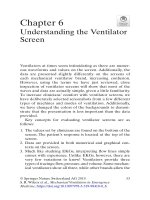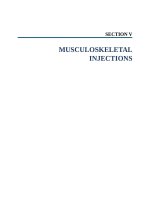Ebook On rounds - 1000 internal medicine pearls: Part 1
Bạn đang xem bản rút gọn của tài liệu. Xem và tải ngay bản đầy đủ của tài liệu tại đây (1.66 MB, 134 trang )
OnRounds:
1000Internal
MedicinePearls
ClinicalAphorismsandRelatedPathophysiology
LewisLandsberg,MD
IrvingS.CutterProfessor
DeanEmeritus
NorthwesternUniversity
FeinbergSchoolofMedicine
Chicago,IL
ExecutiveEditor:RebeccaGaertner
SeniorProductDevelopmentEditor:KristinaOberle
ProductionProjectManager:BridgettDougherty
MarketingManager:StephanieKindlick
DesignCoordinator:JoanWendt
SeniorManufacturingCoordinator:BethWelsh
PrepressVendor:Aptara,Inc.
Copyright©2016byWoltersKluwerHealth
Allrightsreserved.Thisbookisprotectedbycopyright.Nopartofthisbookmaybereproducedortransmittedinanyformor
byanymeans,includingasphotocopiesorscanned-inorotherelectroniccopies,orutilizedbyanyinformationstorageand
retrievalsystemwithoutwrittenpermissionfromthecopyrightowner,exceptforbriefquotationsembodiedincriticalarticles
andreviews.MaterialsappearinginthisbookpreparedbyindividualsaspartoftheirofficialdutiesasU.S.government
employeesarenotcoveredbytheabove-mentionedcopyright.Torequestpermission,pleasecontactWoltersKluweratTwo
CommerceSquare,2001MarketStreet,Philadelphia,PA19103,viaemailat,orviaourwebsiteat
lww.com(productsandservices).
987654321
PrintedinChina
978-1-49632-221-0
LibraryofCongressCataloging-in-PublicationData
availableuponrequest
Thisworkisprovided“asis,”andthepublisherdisclaimsanyandallwarranties,expressorimplied,includinganywarranties
astoaccuracy,comprehensiveness,orcurrencyofthecontentofthiswork.
Thisworkisnosubstituteforindividualpatientassessmentbaseduponhealthcareprofessionals’examinationofeachpatient
andconsiderationof,amongotherthings,age,weight,gender,currentorpriormedicalconditions,medicationhistory,
laboratorydataandotherfactorsuniquetothepatient.Thepublisherdoesnotprovidemedicaladviceorguidanceandthis
workismerelyareferencetool.Healthcareprofessionals,andnotthepublisher,aresolelyresponsiblefortheuseofthiswork
includingallmedicaljudgmentsandforanyresultingdiagnosisandtreatments.
Givencontinuous,rapidadvancesinmedicalscienceandhealthinformation,independentprofessionalverificationofmedical
diagnoses,indications,appropriatepharmaceuticalselectionsanddosages,andtreatmentoptionsshouldbemadeand
healthcareprofessionalsshouldconsultavarietyofsources.Whenprescribingmedication,healthcareprofessionalsareadvised
toconsulttheproductinformationsheet(themanufacturer’spackageinsert)accompanyingeachdrugtoverify,amongother
things,conditionsofuse,warningsandsideeffectsandidentifyanychangesindosagescheduleorcontraindications,
particularlyifthemedicationtobeadministeredisnew,infrequentlyusedorhasanarrowtherapeuticrange.Tothemaximum
extentpermittedunderapplicablelaw,noresponsibilityisassumedbythepublisherforanyinjuryand/ordamagetopersons
orproperty,asamatterofproductsliability,negligencelaworotherwise,orfromanyreferencetoorusebyanypersonofthis
work.
LWW.com
Dedication
TomywifeJill,withoutwhomthisbookwouldnothavebeenwritten;tomystudents,
residents,andyoungcolleaguesatYale,Harvard,andNorthwesternwhohavetaughtme
morethantheycouldeverimagine;andtomyinterngroupatYale,whosefriendshiphas
beenalifelongtreasure.
ACKNOWLEDGMENTS
O
f the many mentors who have shaped my career I would like to specifically
acknowledgePaulB.Beeson,FranklinH.Epstein,PhilipK.Bondy,EugeneBraunwald,
and Julius Axelrod. Each of these men served as a beacon, a shining example of the
clinician/scientistthatIhavestrived,imperfectly,toemulate.
I thank Ms. Linda Carey for her skillful assistance and meticulous attention to detail in
thepreparationofthismanuscriptandforherunfailinggoodcheer.
SpecialthankstoMs.RebeccaGaertneratLWWforherencouragementandsoundadvice
that contributed importantly to the final form of this book. And special thanks as well to
Ms. Kristina Oberle at LWW for her expert editorial assistance and excellent taste in
formattingthemanuscript.Havingsaidthat,Ialonebearresponsibilityforanyerrorsthat
foundtheirwayintothisbook.
Finally, I thank my daughter Alison, for invaluable advice about academic publishing,
andmysonJuddformanyfruitfuldiscussionsaboutcongestiveheartfailure,extracellular
fluid balance, and pulmonary function, and both of them and their spouses for Eli, Leah,
Maya,Lucas,andJonah.
PREFACE
T
hismonographisacompilationofaphorismsthatIhavefoundusefulinalmosthalfa
century of clinical experience in internal medicine. They are the distillation of my
interest in the clinical manifestations and the pathophysiology of disease. In many
instancestheaphorismsarederivedfrommyownclinicalobservations;insomecasesthey
reflecttheexperienceandwisdomofothersthatIhavecometoappreciateandvalueover
the years. In every case the aphorisms cited here, which I refer to by the time-honored
designation as “pearls,” have met the test of veracity and usefulness in my own clinical
experience.
While no “pearl” is applicable one hundred percent of the time, I believe, nonetheless,
that the ready recall of pithy statements of fact are useful aids to prompt diagnosis and
treatment. Clinical medicine is filled with uncertainty, and pearls, these nuggets of
accumulatedwisdom,frequentlysimplifycomplicatedsituationsandarethereforeusefulto
both physicians in training and physicians in practice. In one sense these aphorisms
represent the information store that experienced clinicians can readily bring to bear on a
clinicalproblem.Alargerepertoryoffactsisadistinguishingfeatureof“master”clinicians,
andanimportantresourceofhighlyregardedclinicalteachers.
The“pearls,”indicatedinboldface,areorganizedbyorgansystemsforeaseofreference.
There is no attempt for the coverage to be comprehensive. This is not a textbook of
medicine. The content reflects my own interests and experience. I have paid particular
attentiontothoseareasthat,inmyexperience,havebeenasourceofconfusionforstudents
andtrainees.
I have also presented relevant physiology where knowledge of the underlying
mechanisms improves understanding of disease pathogenesis and aids in retention of the
pearls.IntegrativephysiologyislesswelltaughtnowthanpreviouslyandIbelievesomeof
thematerialpresentedheremayaddressthatdeficiency.
Also included are a few “faux pearls” – statements that, although widely believed – are
demonstrablyfalse.
This monograph is intended for students of internal medicine. I mean students in the
broad sense to include not only medical students and residents but also mature clinicians
whocanthinkabouttheseaphorismsandtheunderlyingphysiologyinrelationtotheirown
clinical experience. This book can also serve as a scaffold for the organization and
augmentation of an already existing clinical data base. It should be of particular value to
thosecliniciansthatteachmedicalstudentsandresidents.
CONTENTS
Acknowledgments
Preface
1THECLINICALEVALUATION
HISTORY
HistoryofPresentIllness(HPI)
Pain
THEPHYSICALEXAMINATION
LABORATORYTESTS
IMAGING
UsefulnessoftheChestX-ray
SOMEWIDELYAPPLICABLECLINICALAPHORISMS
Occam’sRazor:TheLawofParsimonyasAppliedtoDiagnosis
Therapeutics
2BLOOD
ANEMIA
CharacterizationoftheAnemia
MicrocyticAnemias
HemolyticAnemias
MicroangiopathicHemolyticAnemia
AutoimmuneHemolyticAnemia
MegaloblasticAnemias
PerniciousAnemia(PA)
FolateDeficiency
HemoglobinAbnormalities
OxidativeDamagetoRBCs
G6PDDeficiency
Methemoglobinemia
Hemoglobinopathies
Normochromic–NormocyticAnemia
PLATELETS
ThrombocytopeniaandPurpura
IdiopathicThrombocytopenicPurpura(ITP)
ThromboticThrombocytopenicPurpura(TTP)
DisseminatedIntravascularCoagulation(DIC)
Drug-inducedThrombocytopenias
OtherCausesofPetechiaeandPurpura
OTHERCHANGESINTHECELLULARELEMENTSOFTHEBLOOD
Erythrocytosis
Thrombocytosis
Neutropenias
LymphopeniaandLymphocytosis
Leukocytosis
THROMBOTICDISORDERSANDCOAGULOPATHIES
ProthromboticDiatheses
Coagulopathies
3RHEUMATOLOGY:ARTHRITIS,AUTOIMMUNEANDCOLLAGENVASCULAR
DISEASES
ARTHRITIS
Osteoarthritis(DegenerativeJointDisease[DJD])
OlecranonBursitis
RheumatoidArthritis(RA)
AdultStill’sDisease(JuvenileRheumatoidArthritis)
PsoriaticArthritis
ReactiveArthritis
CrystalDepositionArthridities:UricAcidandCalciumPyrophosphate
ANCA-ASSOCIATEDVASCULITIDES
Wegener’sGranulomatosis(GranulomatosiswithPolyangiitis[GPA])
MicroscopicPolyangiitis(MPA)
Churg–StraussSyndrome(CSS)
Drug-inducedANCA–AssociatedVasculitis(AAV)
NON-ANCA–ASSOCIATEDVASCULITIDES
Behcet’sSyndrome
Cryoglobulinemia
GiantCellArteritis(GCA)
COLLAGENVASCULARDISEASES
Scleroderma(SystemicSclerosis)
PolyarteritisNodosa(PAN)
Polymyositis
Dermatomyositis(DM)
SystemicLupusErythematosus(SLE)
Drug-inducedLupus
AMYLOIDOSIS
PrimaryAmyloidosis(AL)
SecondaryAmyloidosis(AA)
Familial(ATTR)andSenileAmyloidosis(ATTRw)
IgG4-RELATEDDISEASE
PAGET’SDISEASEOFBONE
SEVEREDRUGREACTIONS
THEDRESSSYNDROME(DRUGREACTION,RASH,EOSINOPHILIA,SYSTEMIC
SYMPTOMS)
AnaphylacticReactions
4THEHEARTANDCIRCULATION
CONGESTIVEHEARTFAILURE(CHF)
ThePathophysiologyofHeartFailure
CHFandPregnancy
CARDIACISCHEMIA
ChestPain
MyocardialIschemiaandInfarction
PERICARDITIS
AcutePericarditis
ChronicConstrictivePericarditis
VALVULARCARDIACLESIONS
AorticStenosis
AorticRegurgitation
MitralStenosis
MitralRegurgitation
TricuspidRegurgitation
LEFTVENTRICULARHYPERTROPHY(LVH)ANDHYPERTROPHIC
CARDIOMYOPATHY(HCM)
CONGENITALHEARTDISEASEINADULTS
ORTHOSTATICHYPOTENSION
SYNCOPE
Vasovagal(Neurogenic)Syncope
CardiacSyncope
5HYPERTENSION
ESSENTIALHYPERTENSION
ThePressure–NatriuresisRelationship
MALIGNANTHYPERTENSION
SECONDARYHYPERTENSION
RenalArteryStenosis
PrimaryAldosteronism
Pheochromocytoma
Cushing’sSyndrome
PolycysticKidneyDisease(PKD)
AORTICDISSECTION
6THEKIDNEYANDDISORDERSOFFLUIDANDACID–BASEBALANCE
ABNORMALRENALFUNCTIONTESTS
BunandCreatinine
PlasmaVolumeAssessment
HYPONATREMIA
VolumeDepletionHyponatremia
DilutionalHyponatremia
SyndromeofInappropriateSecretionofADH(SIADH)
URINARYSODIUMANDPOTASSIUM
SodiumandPotassiumBalance
ACID–BASEDISTURBANCES
MetabolicAcidosis
AcidosisinRenalDisease
MetabolicAlkalosis
RespiratoryAlkalosis
INTRINSICRENALDISEASE
TubulointerstitialDisease
Glomerulonephritis
NephroticSyndrome
7ENDOCRINOLOGYANDMETABOLISM
DIABETESMELLITUS
DiabeticComplications
DiabeticKetoacidosis
HyperosmolarNonketoticComa
HYPOGLYCEMIA
Pathophysiology
GlucoseCounterregulation
SymptomsofHypoglycemia
CausesofHypoglycemia
MULTIPLEENDOCRINENEOPLASIASYNDROMES
MEN1
MEN2A
MEN2B
THYROIDDISEASE
ThyroidFunctionTests
Hyperthyroidism
Hypothyroidism
CALCIUM
Hypercalcemia
Hypocalcemia
Hypophosphatemia
POLYURIA
ThePosteriorPituitaryGland(DiabetesInsipidus[DI])
ANTERIORPITUITARY
Prolactin
GrowthHormone
PituitaryInfarction
CerebrospinalFluid(CSF)Rhinorrhea
ADRENALCORTEX
AdrenalFunctionTesting
AdrenalInsufficiency
AdrenalSuppression
AdrenocorticalExcess
Bartter’sSyndrome
AnorexiaNervosa
8FEVER,TEMPERATUREREGULATION,ANDTHERMOGENESIS
CENTRALREGULATIONOFCORETEMPERATURE
FEVERANDHYPERTHERMIA
THERMOGENESIS
HEATGENERATIONANDDISSIPATION
DIURNALVARIATIONINTEMPERATURE
NIGHTSWEATS
9INFECTIOUSDISEASES
FEVEROFUNKNOWNORIGIN
INFECTIONSOFSPECIFICSITES
UrinaryTractandKidney
Liver
SpineandEpiduralSpace
Pharyngitis
LungAbscess
BowelInfections
ViralGastroenteritis
BACTERIALGASTROENTERITIS
Salmonella
Campylobacter
Shigella
PathogenicEscherichiacoli
Clostridiumdifficile(C.diff)
StaphylococcalEnterotoxinEnteritis
SPECIFICINFECTIOUSAGENTS
Gonococci(GC)
Meningococci
StaphylococcalInfections
Syphilis(Lues)
HerpesZoster
HerpesSimplexVirus(HSV)
GLOBALIZATIONANDINFECTIOUSDISEASE
Malaria
DiseasesthathaveSpreadBeyondtheirTraditionalLocales
10PULMONARY
BLOODGASES
HypoxemiaandHypercapnia
ObstructiveSleepApnea
HyperventilationSyndrome
PULMONARYFUNCTIONTESTS
PNEUMONIA
“Typical”Pneumonias
Influenza
AtypicalPneumonia
EosinophiliaandPulmonaryInfiltrates
SARCOIDOSIS
PulmonaryInvolvementinSarcoidosis
ExtrapulmonaryManifestationsofSarcoidosis
TUBERCULOSIS(TB)
UpperLobeLocalization
PleuralEffusionswithTB
ExtrathoracicTuberculosis
ASPERGILLOSIS
PULMONARYTHROMBOEMBOLICDISEASE
11THEGASTROINTESTINALTRACT,PANCREAS,ANDLIVER
THEGASTROINTESTINALTRACT
FunctionalGastrointestinalDisease
IrritableBowelSyndrome
InflammatoryBowelDisease
GastrointestinalBleedingfromPepticUlcerDisease
HereditaryHemorrhagicTelangiectasia(Osler–Weber–RenduDisease)
LowerGastrointestinalBleeding
Malabsorption
CeliacDisease
TropicalSprue
BacterialOvergrowth
PancreaticInsufficiency
InfectionsandMalabsorption
Zollinger–EllisonSyndrome(Gastrinoma)
THEPANCREAS
AcutePancreatitis
BILIARYTRACTDISEASE
BiliaryColicandAcuteCholecystitis
BiliaryCirrhosis
PORTALCIRRHOSIS
HepaticEncephalopathy
HepatorenalSyndrome(HRS)andHepatopulmonarySyndrome
CARCINOIDTUMORS
CarcinoidTumorsandtheMalignantCarcinoidSyndrome
12OBESITY
PATHOGENESISOFOBESITY
TheEnergyBalanceEquation
ThriftyMetabolicTraits
CARDIOVASCULARANDMETABOLICCONSEQUENCESOFOBESITY
OBESITYANDOTHERDISEASES
13MALIGNANCYANDPARANEOPLASTICSYNDROMES
BRONCHOGENICCARCINOMA
LungCancerMetastases
SuperiorVenaCava(SVC)Syndrome
DigitalClubbing
ParaneoplasticSyndromes
AdenocarcinomaoftheLung
SquamousCellCarcinomaoftheLung
SmallCellCarcinomaoftheLung
RENALCELLCARCINOMA
MULTIPLEMYELOMA
RenalInvolvementinMyeloma
ImpairedAntibodyProductioninMyeloma
PlasmaCellDyscrasiasRelatedtoMyeloma
Waldenstrom’sMacroglobulinemia
HeavyChainDisease
14NEUROMUSCULARDISEASE
HEADACHE
Temporal(Cranial)Arteritis
Migraine
TensionHeadache
HeadacheswithIncreasedIntracranialPressure
NormalPressureHydrocephalus(NPH)
ACUTECEREBROVASCULAREVENTS(STROKES)
IschemicStrokes
CerebralHemorrhage
DropAttacks
WEAKNESS
SpinalCord
Myopathy
Guillain–BarreSyndrome
PostviralNeurasthenia
MyastheniaGravis
Lambert–EatonMyasthenicSyndrome(LEMS)
Neuropathies
DiabeticNeuropathy
MOTORNEURONDISEASE
AmyotrophicLateralSclerosis(ALS)
RHABDOMYOLYSIS
McArdle’sSyndrome
COMPLICATIONSOFPSYCHOTROPICDRUGS
SEIZURES
15COMPLICATIONSOFALCOHOLISM
NERVOUSSYSTEM
PeripheralNerves
CentralNervousSystem
ALCOHOLWITHDRAWALSYNDROMES
ALCOHOLANDTHEHEART
HEMATOLOGICCONSEQUENCESOFALCOHOLISM
DirectToxicEffectsofAlcohol
FolateDeficiency
Alcohol-inducedCoagulopathy
Index
1
TheClinicalEvaluation
CHAPTER
HISTORY
HistoryofPresentIllness(HPI)
Pain
THEPHYSICALEXAMINATION
LABORATORYTESTS
IMAGING
UsefulnessoftheChestX-ray
SOMEWIDELYAPPLICABLECLINICALAPHORISMS
Occam’sRazor:TheLawofParsimonyasAppliedtoDiagnosis
Therapeutics
HISTORY
HistoryofPresentIllness(HPI)
TheHPIisthekeytothediagnosis,startingwiththechiefcomplaint.Theclinical
evaluation(historyplusphysicalexamination)guidestheselectionoftests,
whichareobtainedtoconfirmorruleoutdiagnosessuggestedclinically,an
aphorismwidelyknownas“Sutton’slaw.”
Willie Sutton, a legendary bank robber, escaped from prison three times and always
returnedtobankrobbing.Whenaskedwhyherobbedbankshegavewhathasbecomean
iconicreply:“…becausethat’swherethemoneyis.”
TheHPIorientsthecliniciantothepatient’sproblemandestablishesaninitial
differentialdiagnosis.Ofmajorimportanceisthetemporalsequenceand
progressionofsymptoms.
ElementsfromtheReviewofSystemsandthePastMedicalHistorythatarerelevanttothe
patient’scomplaintshouldbepartoftheHPI.Pertinentnegativesshouldbeenumerated.If
notspecificallystated,anegativecannotbeinferred;itmustbepresumedthatthequestion
wasnotasked.
Symptomsthathavealimiteddifferentialareparticularlyimportant.
Paroxysmalnocturnaldyspnea(PND),whenclassic,meansleftheartfailure;by
contrast,orthopneahasanextensivedifferentialandismuchlessspecific
althoughitisalsoamanifestationofheartfailure.
This distinction is only meaningful when the features of PND are known and understood:
awakeningfromasleepafterabout2hours(usuallyaround2 AM)withshortnessofbreath,
gettingoutofbed,andsittinginachair,usuallyfortherestofthenight.
PNDresultsfromthegradualredistributionoffluid,accumulatedintheperiphery(lower
extremities) during the day, to the central compartment where the ensuing volume load
exceeds the output capacity of the compromised myocardium raising the end diastolic
pressureoftheleftventricle.Bycontrast,inavarietyofdiseasesbreathingismadeeasier
uprightthansupine(orthopnea)andthediscomfortisfeltimmediatelyonlyingdown.
Anotherusefulexampleofahighlyspecificfindingincludesmononeuritis
multiplex.Indistinctiontothemuchmorecommonpolyneuritis,whichhasa
myriadofcauses,mononeuritismultiplexhasamuchnarrowerdifferentialthat
includescollagenvasculardisease(particularly,rheumatoidarthritis,
polyarteritisnodosa,andthevariousvasculiticsyndromes),diabetesmellitus,
andcancer.
Pain
Painisafrequentpresentingcomplaintformanydiseases.Thehistoryprovidesimportant
diagnosticcluesabouttheoriginofpain.
Painthatisaggravatedbymovement,andthatmakesthepatientliestillis
characteristicofaninflammatoryprocess.
Thepatient’sreactiontopainismoreimportantthanthesubjectivedescriptionsofthepain
itself.
Withanacuteinflammatoryabdominalprocesslikecholecystitisorpancreatitis
thepatientliesabsolutelystill.
Colic,painthatwaxesandwanes,indicatespressurechangesinahollowviscus
suchasthebiliarysystemorureter;itisbroughtonbyobstruction,usuallyfrom
astone.Theresponsetocolickypainischaracterizedbyaninabilitytoget
comfortableandbywrithingaroundorpacingthefloor.
Maneuversthataccentuateoramelioratethepainarealsoimportanttonote.
Pleuritic chest pain, for example, is worsened by deep breathing or coughing, reflecting
inflammationoftheparietalpleura.
THEPHYSICALEXAMINATION
Tobecomeexpertatphysicalexaminationrequirespractice.Establishingthe
boundsofnormality,andthereforetheabilitytoelicittheabnormalfinding
whenpresent,requiresexperienceandattentiontodetail.
Although advanced imaging and other testing have unfortunately and inappropriately
denigrated the value of physical examination (PE), it remains the cornerstone of clinical
evaluationforthefollowingreasons.
1.Itisvirtuallyharmless,distinguishingitfrommanyothermodesofevaluation.
2.Alongwiththehistoryitguidesallsubsequentinvestigations.
3.Itisneitherfeasiblenordesirabletodowidespreadtestingwithoutaclinicalevaluation
first.Whenpriorprobabilityofadiseaseislow,false-positivetestsabound.
4.Itisusefulforassessingprogressionofdiseaseandresponsetotreatment.
5.The“layingonofhands”strengthensthephysician–patientrelationship.
When encountering a new patient with an undiagnosed disease a full examination should
be performed and all organ systems assessed even while concentrating on the area
suggestedbythehistory.Afullexaminationincludesnotinganddescribingtheattitudeof
thepatientinbedandacarefulrecordingofthevitalsigns.Inadditiontolisteningtothe
chestandpalpatingtheabdomen,feelingforallpulses,testingstrengthinallmajormuscle
groups, eliciting and recording all reflexes, assessing the cranial nerves, and (with some
exceptions)agenitalandrectalexaminationshouldbepartofeveryphysical.
Inapatientwithlegpain,forexample,howwillyoubecertainofanabsentpedalpulse
ifyouhavenotexaminedthisinmanypatientswithoutlowerextremityvasculardisease?
In assessing the likelihood of increased intracranial pressure how will you identify
papilledema if you have not examined many normal fundi and noted the presence (or
absence)ofvenouspulsations?
LABORATORYTESTS
Neverletasinglelaboratoryresultdissuadeyoufromadiagnosisstrongly
suggestedbytheweightoftheclinicalfindings.
Discordantlaboratoryresultsshouldberepeated.
Alwaysstartwiththeleastspecializedtests.ACBCisalwaysindicatedintheevaluation
ofasickpatientwherethediagnosisisnotknown.TheCBCcontainsalotofinformation,
muchofwhichisfrequentlyoverlooked.
AWBCwithoutadifferentialisnotinterpretableandthereforeuseless.
The percentage of polymorphonuclear leukocytes (granulocytes) and the presence of
immature forms (bands), in comparison to the percentage of mononuclear cells
(lymphocytesplusmonocytes)areofparticularimportance.
Thepresenceofeosinophilsarguesforcefullyagainstbacterialinfection.
In the absence of a documented pre-existing cause for eosinophilia the usual mediators of
inflammation and the hormonal response to severe illness effectively clear the blood of
eosinophils.
Toxicgranulation,anoutpouringofimmaturegranulocyteswithlargegranules
andvacuoles,indicatesinfection.
Anelevatedplateletcountisaverygoodmarkerofaninflammatoryprocess.
Anelevatedsedimentationrate(ESR)isunlikelytobehelpfulexceptincasesof
temporalarteritisorsubacutethyroiditis,whereveryhighvaluesaretherule.
ESRmaybenormalinthefaceofsignificantinflammationandmodestelevationsaretoo
nonspecifictobeuseful.
ESRmay,however,beelevatedindysproteinemiaswheretheparaproteincauses
clumpingoftheredcellsorrouleauxformation.
Examinationofthebloodsmear,therefore,mayprovideusefulcluestothediagnosis.
IMAGING
UsefulnessoftheChestX-ray
Although modern imaging techniques and sophisticated computer software have
revolutionized diagnosis (as described in specific situations throughout this book), it is
surprisingthatthesimplechestx-raystillprovidesmuchusefulinformation.
Althoughmuchlessfrequentlyusednowthaninthepast,thePAandlateralchest
x-raycanprovidemuchusefulinformation.PortableAPfilmsaremuchless
helpful.
Thereisnosubstituteforpersonallyreviewingthechestx-ray.
Specificcardiacchamberenlargementcanbeassessedfromthelateralview.
The right ventricle comprises the anterior border of the cardiac silhouette in the lateral
view.Normally,therightventricleabutsthesternumone-thirdofthewayupandonavery
steepangle;withrightventricularhypertrophythecardiacsilhouettehitsthesternumonehalf way up, the retrosternal space is diminished, and the angle is no longer acute (one
couldstandonitwithoutfallingoff!).Theposteriorborderoftheheartinthelateralview
ismadeupoftheleftventricle.Withleftventricularhypertrophytheretrocardiacspaceis
compromisedandtheangleformedwiththeinferiorvenacavaisdiminished.
Calcificationinthecostochondralcartilageintheelderlyisfrequentlyassociated
withmitralannuluscalcification,sotheformershouldpromptalookforthe
latter.
Thismaybeanimportantcluetothepresenceofsignificantmitralregurgitation.
Inevaluatingpneumonicinfiltratesthepresenceorabsenceofairbronchograms
andtheeffectoftheinfiltrateonlungvolumeprovidesignificantinformationas
totheunderlyingcause.
Air bronchograms without loss of volume indicate a pneumonic consolidation like
pneumonia,aso-calledalveolarinfiltrate;volumelossimpliesbronchialobstruction.
Locationoftheabnormalityisimportant:upperlobeinfiltratessuggest
tuberculosis(TB)orfungalinfection.TBislocatedclassicallyintheposterior
segmentoftheupperlobe;fungaldiseaseintheanteriorsegment.Bullaeare
typicallylocatedintheupperlobes;middleorlowerlobebullaesuggestα1antitrypsindeficiency.
Thelateralviewisalsohelpfulinassessinghilarfullness;adenseshadowintheshapeofa
donutsuggestshilarlymphadenopathy;pulmonaryvesselsappearmuchlessdense.
Whenthelefthemidiaphragmishigherthantheright,thepossibilityofa
subdiaphragmaticprocess(abscess,enlargedspleen,adrenalmass)shouldbe
considered.
Therighthemidiaphragmisnormallyhigherthantheleftbecauseitsitsontheliverbelow.
Inabilityto“takeadeepbreath”duringachestx-raydoesnotreflectan
inadequateattemptbythepatient.
There is usually an underlying cause such as pain (in the chest or abdomen), muscle
weakness, or congestive heart failure. In the latter excess fluid in the lung parenchyma
decreases compliance and restricts the ability to “take a deep breath.” It is a faux pearl
thatthediminisheddiaphragmaticexcursionreflects“poorinspiratoryeffort.”
SOMEWIDELYAPPLICABLECLINICALAPHORISMS
Occam’sRazor:TheLawofParsimonyasAppliedtoDiagnosis
Patientsfrequentlypresentwithconstellationsofsymptomsandsignsthatmay
appearunrelated;ingeneral,thebestdiagnosiswillencompassanexplanation
thataccountsforallthefindings.
Occam’s razor cuts best in younger patients. In the elderly, the coincidental occurrence of
severaldiseaseswilloftencontributetotheclinicalpicture.
Theexperiencedclinicianwillquicklyidentifythefewcrucialfindingsina
complicatedcasethatmustbeexplainedbythediagnosis.
Thesewilloftenleadtoanappropriatedifferentialandpointtothecorrectdiagnosis.
Thefinaldiagnosismustexplainthechiefcomplaint.
Therapeutics
Youcan’tmakeanasymptomaticpatientfeelbetter.(“Nevershootasinging
bird.”)
Relatedoldadagesinclude:primumnonnocere(firstlydonoharm);lessisfrequentlymore
intheelderly.Loeb’sfirstandsecondlawsstatetheobvious:ifapatientimprovesduringa
courseoftreatment,continueit;ifapatientworsensundertreatment,stopit.(RobertLoeb
wasarenownedprofessorofmedicineatColumbia.)Loeb’sthirdlawhasbeenbannedin
theinterestsofprofessionalism(“nevertrustasurgeon”).
2
Blood
CHAPTER
ANEMIA
CharacterizationoftheAnemia
MicrocyticAnemias
HemolyticAnemias
MicroangiopathicHemolyticAnemia
AutoimmuneHemolyticAnemia
MegaloblasticAnemias
PerniciousAnemia(PA)
FolateDeficiency
HemoglobinAbnormalities
OxidativeDamagetoRBCs
G6PDDeficiency
Methemoglobinemia
Hemoglobinopathies
Normochromic–NormocyticAnemia
PLATELETS
ThrombocytopeniaandPurpura
IdiopathicThrombocytopenicPurpura(ITP)
ThromboticThrombocytopenicPurpura(TTP)
DisseminatedIntravascularCoagulation(DIC)
Drug-inducedThrombocytopenias
OtherCausesofPetechiaeandPurpura
OTHERCHANGESINTHECELLULARELEMENTSOFTHEBLOOD
Erythrocytosis
Thrombocytosis
Neutropenias
LymphopeniaandLymphocytosis
Leukocytosis
THROMBOTICDISORDERSANDCOAGULOPATHIES
ProthromboticDiatheses
Coagulopathies
T
hecellularelementsofblood,althoughsubjecttospecificdiseasesintheirownright,are
affected in most diseases of other organ systems as well, and in many of these the
changes in the blood contribute to the pathogenesis, the symptomatology, and the
complicationsoftheunderlyingdisease.Thisisreflectedbytheinclusionofawidevariety
oftopicsinthissection.Topicsthatfrequentlycauseconfusionorarepoorlyunderstoodare
dealtwithinsomedetail.
ANEMIA
Loss of oxygen-carrying capacity of the blood results in a myriad of nonspecific but wellknownsymptomssuchasfatigue,headacheandlistlessness,andtachycardia.Paleskinand
conjunctivalpallorareobvioussigns.
Whenthehemoglobin(Hgb)fallsbelow4g/dLthepalmarcreaseslosetheirpink
color,ahallmarkofsevereanemia.
Shortnessofbreathisanunderappreciatedmanifestationofmoderatetosevere
anemia,reflectinginsufficienttissueoxygenation.
Inorgansystemswherethecirculationiscompromisedfromunderlyingvascular
disease,anemiamayprecipitatedramaticsymptoms,resultingindecompensation
ofapreviouslymarginallycompensatedstate.Thisisparticularlytrueforthe
cerebralandthecoronarycirculations.
Thus in patients with underlying coronary artery disease (CAD), angina or myocardial
infarction (MI) may occur, and marginally compensated heart failure may become full
blown; more dramatically, in the presence of asymptomatic cerebrovascular disease, a
complete hemiparesis may develop which reverts with transfusion and restoration of
oxygenation.
CharacterizationoftheAnemia
Red cell indices, developed by Wintrobe in the 1920s, have provided the basis for the
classification of anemic states since that time. They provide a measure of the size (MCV)
andtheHgbcontent(MCHandMCHC)oftheredcells.
MicrocyticAnemias
Hypochromic microcytic anemia (low MCV and low MCH) indicates iron deficiency or
hemoglobinopathy;RBCsarepaleonsmear.
AnemiawithalowMCVinamanmeansbloodloss(irondeficiency)and
necessitatesagastrointestinal(GI)workup.









